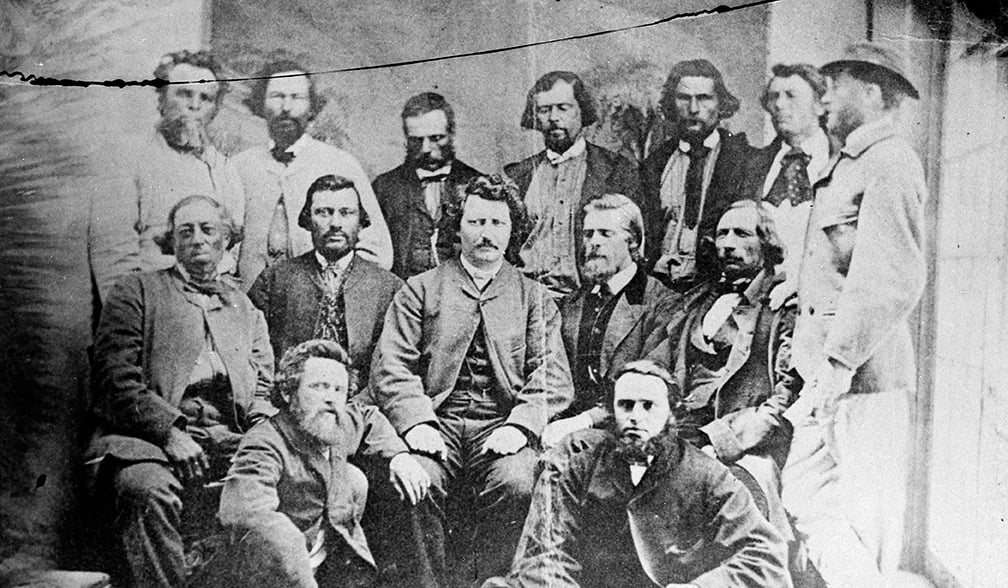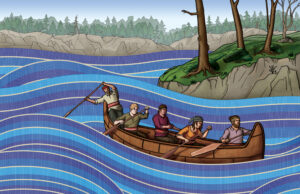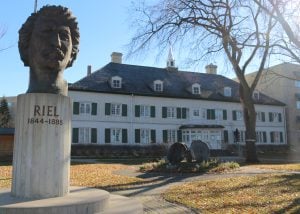
People & Culture
Kahkiihtwaam ee-pee-kiiweehtataahk: Bringing it back home again
The story of how a critically endangered Indigenous language can be saved
- 6310 words
- 26 minutes
People & Culture
A celebration of the real Louis Riel, Métis leader and Manitoba founder, on the 150th anniversary of the Red River Resistance and the 175th of his birth

Shortly after the 110th commemoration of Louis Riel’s execution, I was asked to emcee the official unveiling of a controversial statue of the Métis leader on Nov. 30, 1995, on the campus of what is now the Université de Saint-Boniface in Winnipeg. Sculptor Marcien Lemay’s naked, bound, contorted and confined Riel spoke to the leader’s inner conflict and suffering as a martyr. Surrounding the figure are walls designed by architect Étienne Gaboury engraved with Riel’s famous words, “I know that through the grace of God I am the founder of Manitoba.” The statue and its walls originally stood on the grounds of the Manitoba Legislative Building, but after Métis protested Lemay’s depiction as insulting both to Riel and to his people, it was replaced with artist Miguel Joyal’s depiction of Riel, in which he appears more statesman-like, assertively brandishing the List of Rights that was to form the basis of the Manitoba Act in 1870.
These two sides of Riel — martyr and statesman — make it challenging for me to write about him. His radical political thoughts after a religious epiphany in 1875 have always made me uncomfortable. And to write on Riel the man means dealing with that side of him. As a Métis law professor and social scientist, I’ve always tried to avoid the “great man” historical narratives on Riel. It’s almost as if people can’t help but unconsciously cast Métis history in terms of Christian narratives: “Strike the shepherd, and the sheep will be scattered; I will turn my hand against the little ones.”
Riel was, at the same time, Lemay’s visionary prophet of the New World and Joyal’s hard-nosed political pragmatist and founder of Manitoba. As Anishinaabe author Basil Johnston wrote of the cultural hero Nanabush, “he could be generous or miserly; he could be true or he could be false; loving or hating. As an Anishinaabe, Nanabush was human, noble and strong, or ignoble and weak.” The same is true for Riel — if we are to embrace him, we must embrace him in his entirety, not simply laud those aspects of him that are comfortable or convenient.

Riel was an atypical Métis. He was born in 1844 in St. Boniface in the Red River Settlement (now Winnipeg) in what was then known as Rupert’s Land. While the average Métis would have never even seen an eastern Canadian city, such as Montreal, Riel left his birthplace when he was 13 to train as a missionary at the Collège de Montréal, along with Quebec’s future political and business elites. In 1865, he left the college to begin a clerkship with lawyer Rodolphe Laflamme, a radical member of the Parti rouge who took two political stances that left an indelible mark on Riel’s vision of the Northwest (encompassing the North-Western Territory and Rupert’s Land, which were not yet part of the Dominion of Canada): anti-Confederation and annexation of Canada to the United States.
On June 12, 1866, Riel and Marie-Julie Guernon signed a marriage contract, but her parents refused to approve of her marrying a “bandit,” an oblique reference to his mixed ancestry. A week later, Riel left Montreal for Rupert’s Land, but before returning to St. Boniface in the Red River Settlement, he lived in Minneapolis and St. Paul, Minn. These were cities that his fellow Métis were actually familiar with, as they plied their transportation trade along the well-worn Red River cart trails.
When Riel finally arrived in St. Boniface on July 26, 1868, at the age of 23, things began to quickly change in the Red River Settlement, where approximately 10,000 Métis formed the majority population. Hudson’s Bay Company owned the North-Western Territory and Rupert’s Land, but the westward expansion of the United States threatened Prime Minister John A. Macdonald’s vision of Canada, and Macdonald began to assert dominion over the region. This threatened the independence of the Métis, and they began to form mounted patrols, led by Riel, to stop federal surveyors. While it’s often portrayed as little more than squabbling over the boundaries of private lots, it was really about the Métis opposing Canada’s premature exercise of sovereignty over the Northwest, sparking the beginning of the Métis uprising in 1869-70 known as the Red River Resistance. A common refrain from the local population then, and one that we still hear today from Indigenous Peoples, was that the people were not consulted.
Prompted by the federal government’s actions, Riel formed a Provisional Government on Dec. 8, 1869 and drafted a List of Rights for the Métis a few months later with the help of representatives from local parishes, and together they appointed three delegates to negotiate the entry of the Northwest into the Canadian federation. Among the delegates was Father Joseph-Noël Ritchot, a local Roman Catholic priest who received instructions from President Riel to negotiate a Métis land claim, Section 31, of the Manitoba Act.
Just before the Manitoba Act received royal assent in May 1870, tensions in the Red River Settlement reached a tipping point. Thomas Scott, a member of the Canadian Party, a small group of English-speaking Protestants, had tried several times to overthrow Riel’s government and was charged with insubordination and treason. He was executed by a firing squad on Riel’s orders.
Between 1873-74 Riel was elected to federal Parliament three times, and three times the majority of sitting MPs voted to oust him for his role in the Resistance and the execution of Scott. When the Liberal government finally granted Riel amnesty in 1875, it was on condition he accept banishment from Her Majesty’s Dominions for five years. Riel chose to exile himself in the United States, where his thoughts returned to rouge ideas of the American annexation of the Northwest and anti-Confederation, while becoming anti-liberal and embracing ultramontanism, a conservative movement that sought to make the Catholic Church dominant in the affairs of the state.
While attempting to convince U.S. President Ulysses S. Grant to threaten to invade Canada if it did not respect the terms of the Manitoba Act, Riel underwent a religious experience in St. Patrick’s Church in Washington, D.C., on Dec. 8, 1875, in which he said God revealed to him that he was the prophet of the New World and the Métis were God’s last chosen people.
In Riel’s revelation, he was shown that Europe had fallen in decline and the corrupting influence of liberalism in Italy would see the Holy See of the Catholic Church transferred to Montreal for 457 years, then to St. Vital, Man., for 1,876 years, at which point the Second Coming of Christ would occur. As God’s last chosen people, the Métis, who were as yet a young, small and fragile people, had to prepare for their future role.
If we are to embrace Riel, we must embrace him in his entirety, not simply laud those aspects of him that are comfortable or convenient.

Riel is often portrayed as a harbinger of a multicultural Canada, but this is misleading. In many ways, Riel’s views were a product of some commonplace ideas in his day, notably that the Indigenous Peoples of North America were a lost tribe of Israel doomed to die out — known as the myth of the “vanishing Indian.” Riel saw the United States as a “Union of Moral States” where each state contributed a particular moral quality to the whole. In Riel’s view, the particular moral quality of Indigenous Peoples might be termed their “voluntary simplicity,” or their willingness to live a simple lifestyle.
If the 1.4 million acres of land granted to the Métis in the 1870 Manitoba Act were roughly one-seventh of the surface area of the original postage-stamp province, Riel claimed compensation for two-sevenths (which included British Columbia) — one-seventh each for the Métis and First Nations. Should Canada accede to these demands, Riel said he would bring immigrants from 10 nations in Europe and grant each of them their own province. If Canada refused to cede to Métis land claims, Riel would invite German immigrants in the United States to invade Ontario, Quebec and the Maritimes, compensating them with what is now northern Ontario. Riel wanted to erase the Canada-U.S. border from Lake Superior to the Pacific Ocean and bring French and French-Canadian immigrants to Manitoba. Furthermore, he would move all the First Nations and Métis in the United States to Rupert’s Land, where they would intermarry with European immigrants to bring about nine new Métis peoples, in addition to the already existing Métis canadien in Manitoba.
While Riel’s vision of immigration may seem open in some ways, it was closed in many more. Riel notably supported the United States’ 10-year ban on Asian immigration because he believed they did not yet have any moral quality to contribute. While he saw the abolition of slavery as moral progress, he stereotyped the moral state of blacks as being that of obedience and a warm-hearted disposition and did not want to grant them anything. While he did invite American Jews to create a “New Judea” in British Columbia, it was conditional on them converting to Christianity. Riel’s geographical segregation didn’t end there — all nations east of the Rockies and isolated on Vancouver Island were Catholic, while the three Protestant and Jewish nations were grouped together west of the Rockies on British Columbia’s mainland.
For Riel, keeping the Northwest within the Canadian federation or annexing it to the United States were both legitimate options and, in either case, he foresaw a great legislative union of Canada, the United States and Great Britain. Even with regard to French immigrants and French-Canadians coming to Manitoba from the U.S., not all were automatically welcome. He was clear that French-Canadians would have to renounce their nationality, intermarry with Métis and First Nations and assimilate into the Métis nation. Riel also specified that the French-Canadians who came to Manitoba to increase the Métis flock would be “chosen offspring only” (or que des rejetons choisis).
Although Riel wasn’t clear on what he meant by this, he undoubtedly intended that some representative body of the Métis of Manitoba would select immigrants and that staunch Catholicism would be a necessary condition of acceptance. It was only in this way that the Métis canadien, as a new, regenerated people could prepare themselves for their role as a chosen people and receive the Holy See.

I have a picture of my father from about 1939. He is visiting his grandmother, Christine (Justine) Richard and great-grandmother, Marie-Rose Larocque, in St. Eustache, Man., a well-known Métis community. Born in 1865, Larocque would have been five years old by the end of the Red River Resistance. Section 31 of the Manitoba Act granted the Métis 1.4 million acres of land “towards the extinguishment of the [or share of ] Indian Title to the lands in the Province.”
Larocque was among the many Métis who were supposed to receive land scrip, a document that could be redeemed for land, under Section 31, but whose scrip ended up in the hands of speculators. It is an incredibly complex issue, entangled in questions of law, history, political economy and colonial expansionism of the nascent Canadian State. However, Section 31 would not have found its way into the Manitoba Act had it not been for Riel’s insistence on obtaining some kind of land base for the Métis. While this is part of Riel’s legacy, he could not have put forward a land claim settlement without a broad base of support among his people.
In Ojibwe cosmology, ojichaag (the “soul”) travels west after death, while the jiibay (“spirit” or “ghost”) remains with the corpse. It was the student association at the Université de Saint-Boniface that lobbied to have Lemay’s statue erected on campus grounds in 1995. Riel himself was a former student (then St. Boniface College), and his mortal remains were buried in the St. Boniface Cathedral cemetery next to the university, after the Canadian State hanged him for treason on Nov. 16, 1885. It was almost as if we were welcoming Riel’s jiibay back home to where his mortal remains are buried, perhaps to finally rest in peace.
It is Lemay’s Riel of whom I hesitate to write, as if to leave the man his dignity by sparing him the shame of witnessing his humiliation at the hands of the Canadian State again. But the act of exhibiting Riel as an exposed, tortured man represents something profound about the Me?tis people. For it is also we as a people who have been stripped of our dignity — stripped of our lands, of our homes, of our history, of our culture and languages and sometimes our mental health. And yet, the walls that surround Riel’s tortured figure — the institutional walls of a prison or an asylum — put the Canadian State on public display. For this is what Canada did to Riel; this is what Canada has done to us as a people. And it must not be forgotten, hidden or denied
Darren O’Toole is a descendant of the Bois-Brûlé (wiisaakodewinini) of the White Horse Plains in Manitoba and teaches Aboriginal Law and Indigenous Legal Philosophy at the University of Ottawa.
Are you passionate about Canadian geography?
You can support Canadian Geographic in 3 ways:

This story is from the July/August 2019 Issue

People & Culture
The story of how a critically endangered Indigenous language can be saved

People & Culture
“We were tired of hiding behind trees.” The ebb and flow of Métis history as it has unfolded on Ontario’s shores

Travel
One writer’s journey to explore the life of Louis Riel

Places
In Banff National Park, Alberta, as in protected areas across the country, managers find it difficult to balance the desire of people to experience wilderness with an imperative to conserve it